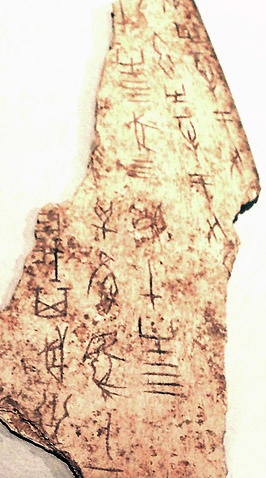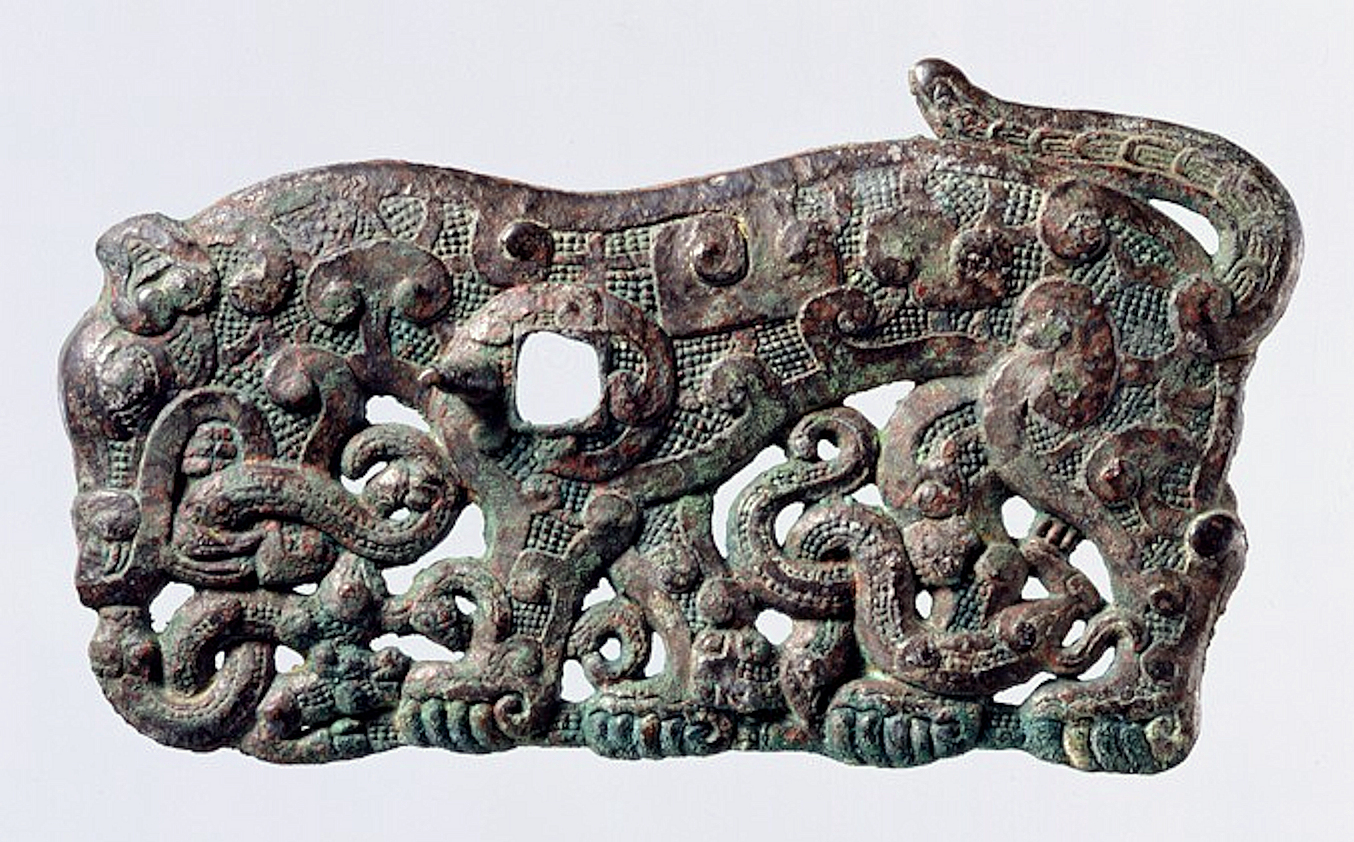|
Oraculology
Oracle bone script is the oldest attested form of written Chinese, dating to the late 2nd millennium BC. Inscriptions were made by carving characters into oracle bones, usually either the shoulder bones of oxen or the plastrons of turtles. The writings themselves mainly record the results of official divinations carried out on behalf of the Late Shang royal family. These divinations took the form of ''scapulimancy'' where the oracle bones were exposed to flames, creating patterns of cracks that were then subjected to interpretation. Both the prompt and interpretation were inscribed on the same piece of bone that had been used for the divination itself. Out of an estimated 150,000 inscriptions that have been uncovered, the vast majority were unearthed at Yinxu, the site of the final Shang capital (modern-day Anyang, Henan). The most recent major discovery was the Huayuanzhuang cache found near the site in 1993. Of the 1,608 Huayuanzhang pieces, 579 bear inscriptions. Each ... [...More Info...] [...Related Items...] OR: [Wikipedia] [Google] [Baidu] |
Oracle Bone
Oracle bones are pieces of ox scapula and turtle plastron which were used in pyromancya form of divinationduring the Late Shang period () in ancient China. '' Scapulimancy'' is the specific term if ox scapulae were used for the divination, ''plastromancy'' if turtle plastrons were used. A recent count estimated that there were about 13,000 bones with a total of a little over 130,000 inscriptions in collections in China and some fourteen other countries. Diviners would submit questions to deities regarding weather, crop planting, the fortunes of members of the royal family, military endeavors, and similar topics. These questions were carved onto the bone or shell in oracle bone script using a sharp tool. Intense heat was then applied with a metal rod until the bone or shell cracked due to thermal expansion. The diviner would then interpret the pattern of cracks and write the prognostication upon the piece as well. Pyromancy with bones continued in China into the Zhou dynasty, bu ... [...More Info...] [...Related Items...] OR: [Wikipedia] [Google] [Baidu] |
Logographic
In a written language, a logogram (from Ancient Greek 'word', and 'that which is drawn or written'), also logograph or lexigraph, is a written character that represents a semantic component of a language, such as a word or morpheme. Chinese characters as used in Written Chinese, Chinese as well as other languages are logograms, as are Egyptian hieroglyphs and characters in cuneiform script. A writing system that primarily uses logograms is called a ''logography''. Non-logographic writing systems, such as alphabets and syllabaries, are ''phonemic'': their individual symbols represent sounds directly and lack any inherent meaning. However, all known logographies have some phonetic component, generally based on the rebus principle, and the addition of a phonetic component to pure ideographs is considered to be a key innovation in enabling the writing system to adequately encode human language. Types of logographic systems Some of the earliest recorded writing systems are logograp ... [...More Info...] [...Related Items...] OR: [Wikipedia] [Google] [Baidu] |
Qin (state)
Qin (, , or ''Ch'in'') was an ancient Chinese state during the Zhou dynasty. It is traditionally dated to 897 BC. The state of Qin originated from a reconquest of western lands that had previously been lost to the Xirong. Its location at the western edge of Chinese civilisation allowed for expansion and development that was not available to its rivals in the North China Plain. After extensive reform during the 4th century BC, Qin emerged as one of the dominant powers among the Seven Warring States. It Qin's wars of unification, unified the seven states of China under Qin Shi Huang in 221 BC. This unification established the Qin dynasty, which, despite its short duration, had a significant influence on later Chinese history. Accordingly, the state of Qin before the Qin dynasty was established is also referred to as the "predynastic Qin" or "proto-Qin". History Founding According to the 2nd-century BC ''Records of the Grand Historian'' by Sima Qian, the state of Qi ... [...More Info...] [...Related Items...] OR: [Wikipedia] [Google] [Baidu] |
Han Dynasty
The Han dynasty was an Dynasties of China, imperial dynasty of China (202 BC9 AD, 25–220 AD) established by Liu Bang and ruled by the House of Liu. The dynasty was preceded by the short-lived Qin dynasty (221–206 BC) and a warring interregnum known as the Chu–Han Contention (206–202 BC), and it was succeeded by the Three Kingdoms period (220–280 AD). The dynasty was briefly interrupted by the Xin dynasty (9–23 AD) established by the usurping regent Wang Mang, and is thus separated into two periods—the #Western Han (202 BC – 9 AD), Western Han (202 BC9 AD) and the #Eastern Han (25–220 AD), Eastern Han (25–220 AD). Spanning over four centuries, the Han dynasty is considered a Golden ages of China, golden age in Chinese history, and had a permanent impact on Chinese identity in later periods. The majority ethnic group of modern China refer to themselves as the "Han people" or "Han Chinese". The spoken Chinese ... [...More Info...] [...Related Items...] OR: [Wikipedia] [Google] [Baidu] |
Shang Bronze And Oracle Script
The Shang dynasty (), also known as the Yin dynasty (), was a Chinese royal dynasty that ruled in the Yellow River valley during the second millennium BC, traditionally succeeding the Xia dynasty and followed by the Western Zhou dynasty. The classic account of the Shang comes from texts such as the ''Book of Documents'', ''Bamboo Annals'' and ''Shiji''. Modern scholarship dates the dynasty between the 16th and 11th centuries BC, with more agreement surrounding the end date than beginning date. The Shang dynasty is the earliest dynasty within traditional Chinese history that is firmly supported by archaeological evidence. The archaeological site of Yinxu, near modern-day Anyang, corresponds to the final Shang capital of Yin. Excavations at Yinxu have revealed eleven major royal tombs, the foundations of former palace buildings, and the remains of both animals and humans that were sacrificed in official state rituals. Tens of thousands of bronze, jade, stone, bo ... [...More Info...] [...Related Items...] OR: [Wikipedia] [Google] [Baidu] |
State Of Qin
Qin (, , or ''Ch'in'') was an ancient Chinese state during the Zhou dynasty. It is traditionally dated to 897 BC. The state of Qin originated from a reconquest of western lands that had previously been lost to the Xirong. Its location at the western edge of Chinese civilisation allowed for expansion and development that was not available to its rivals in the North China Plain. After extensive reform during the 4th century BC, Qin emerged as one of the dominant powers among the Seven Warring States. It Qin's wars of unification, unified the seven states of China under Qin Shi Huang in 221 BC. This unification established the Qin dynasty, which, despite its short duration, had a significant influence on later Chinese history. Accordingly, the state of Qin before the Qin dynasty was established is also referred to as the "predynastic Qin" or "proto-Qin". History Founding According to the 2nd-century BC ''Records of the Grand Historian'' by Sima Qian, the state of Qi ... [...More Info...] [...Related Items...] OR: [Wikipedia] [Google] [Baidu] |
Seal Script
Seal script or sigillary script () is a Chinese script styles, style of writing Chinese characters that was common throughout the latter half of the 1st millennium BC. It evolved organically out of bronze script during the Zhou dynasty (1046–256 BC). The variant of seal script used in the state of Qin eventually became comparatively standardized, and was adopted as the formal script across all of China during the Qin dynasty (221–206 BC). It was still widely used for decorative engraving and seal (East Asia), seals during the Han dynasty (202 BC220 AD). The literal translation given above was coined during the Han dynasty, and reflects the role of the script being reduced to ceremonial inscriptions. Types The term ''seal script'' may refer to several distinct varieties, including the large seal script and the small seal script. Without qualification, ''seal script'' usually refers to the small seal script—that is, the lineage which evolved with ... [...More Info...] [...Related Items...] OR: [Wikipedia] [Google] [Baidu] |
Western Zhou
The Western Zhou ( zh, c=西周, p=Xīzhōu; 771 BC) was a period of Chinese history corresponding roughly to the first half of the Zhou dynasty. It began when King Wu of Zhou overthrew the Shang dynasty at the Battle of Muye and ended in 771 BC when Quanrong pastoralists sacked the Zhou capital at Haojing and killed King You of Zhou. The "Western" label for the period refers to the location of the Zhou royal capitals, which were clustered in the Wei River valley near present-day Xi'an. The early Zhou state was ascendant for about 75 years; thereafter, it gradually lost power. The former lands of the Shang were divided into Ancient Chinese states, hereditary fiefs that became increasingly independent of the Zhou king over time. The Zhou court was driven out of the Wei River valley in 771 BC: this marked the beginning of the Eastern Zhou period, wherein political power was wielded in actuality by the king's nominal vassals. Sources The Western Zhou are known from ... [...More Info...] [...Related Items...] OR: [Wikipedia] [Google] [Baidu] |
Bronzeware Script
Chinese bronze inscriptions, also referred to as bronze script or bronzeware script, comprise Chinese writing made in several styles on ritual bronzes mainly during the Late Shang dynasty () and Western Zhou dynasty (771 BC). Types of bronzes include ''zhong'' bells and '' ding'' tripodal cauldrons. Early inscriptions were almost always made with a stylus into a clay mold, from which the bronze itself was then cast. Additional inscriptions were often later engraved onto bronzes after casting. The bronze inscriptions are one of the earliest scripts in the Chinese family of scripts, preceded by the oracle bone script. Terminology For the early Western Zhou to early Warring States period, the bulk of writing which has been unearthed has been in the form of bronze inscriptions. As a result, it is common to refer to the variety of scripts of this period as "bronze script", even though there is no single such script. The term usually includes bronze inscriptions of the precedin ... [...More Info...] [...Related Items...] OR: [Wikipedia] [Google] [Baidu] |
Oracle Mu4 Eye
An oracle is a person or thing considered to provide insight, wise counsel or prophetic predictions, most notably including precognition of the future, inspired by deities. If done through occultic means, it is a form of divination. Description The word ''oracle'' comes from the Latin verb ''ōrāre'', "to speak" and properly refers to the priest or priestess uttering the prediction. In extended use, ''oracle'' may also refer to the ''site of the oracle'', and the oracular utterances themselves, are called ''khrēsmoí'' (χρησμοί) in Greek. Oracles were thought to be portals through which the gods spoke directly to people. In this sense, they were different from seers (''manteis'', μάντεις) who interpreted signs sent by the gods through bird signs, animal entrails, and other various methods.Flower, Michael Attyah. ''The Seer in Ancient Greece.'' Berkeley: University of California Press, 2008. The most important oracles of Greek antiquity were Pythia (priestes ... [...More Info...] [...Related Items...] OR: [Wikipedia] [Google] [Baidu] |






